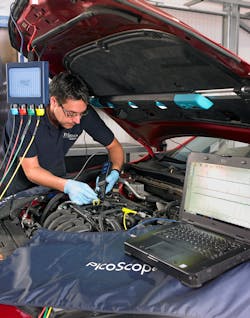In the automotive world, vehicle technology is ever advancing. As elements such as lane departure warnings, collision avoidance, and other ADAS capabilities are integrated into more vehicles out on the road today, technicians need tools and equipment that will help them diagnose the repairs these electrical systems often need. Though screwdrivers and wrenches are still necessary tools for everyday repairs, it is time for more advanced tools to enter technicians’ toolboxes.
“[The oscilloscope] is the tool of the modern technician,” says Bernie Thompson, president of Automotive Test Solutions. “A scope is modern technology that everybody’s going to need.”
Understanding oscilloscopes
As with any tool stocked on a mobile tool distributor’s truck, the tool distributor must know the tool to the sell the tool.
“[An oscilloscope] is used to turn voltage into a readable waveform,” says Chad Schnitz, national sales manager for Autel U.S. “We can use [an oscilloscope] to see the voltage going to or coming from a component. This gives the technician a clear picture of how the system is working and if it is functioning properly.”
Though the main function of an oscilloscope hasn’t changed much over the years, the software paired with them has greatly improved. Over the past ten years, oscilloscope manufacturers such as Pico Technology have added features like noise, vibration, and harshness testing, resistance testing, and temperature testing. Pico’s newest line of oscilloscopes also has automatic probe recognition.
Pico Technology’s Vehicle Manufacturer Accounts Manager, Randy Dillman, explains that to use this feature, technicians need only to plug in the probe and the oscilloscope’s software will recognize the probe. It will then configure the software for the appropriate testing. This allows new users to get the scope set up for testing signals quicker than any other device, which in the past had been a fault of oscilloscopes.
Another advantage of advancing oscilloscope software is improved accessibility for new users.
“Labscope use can be intimidating. In recent years manufacturers have worked hard to provide better information to the end user on how to hook up the system and what good looks like,” says Schnitz. “An example of this would be on the new Autel MaxiSys Ultra. The technician can go directly from a code on the scan tool to a component test. The [MaxiSys Ultra] will automatically set up all the labscope ranges and timeline and present a known good waveform, so the tech knows what to look for. From there the tool shows what the component looks like and where it is located, what the connector looks like, what pins and probes are needed, and how to connect them. This type of information gives a new user the ability to understand the system and get more comfortable with using a scope.”
Market availability
There are many options on the market for oscilloscopes, from different manufacturers to different set-ups as well as features like the number of channels. There’s a lot for technicians to choose from. As a mobile tool dealer, it’s essential to know and understand these options to aid technicians in finding the oscilloscope that best suits their needs.
When buying an oscilloscope there are a few different set-ups technicians can choose from: an oscilloscope as its own device, as a module on a laptop, or an oscilloscope module built into a scan tool.
An oscilloscope on its own is rare, as a screen is needed to see the waveforms and tends to be rather expensive. According to Autel’s Schnitz, AESWave has an “amazing product” called ‘uScope’.
“The uScope is a single channel scope that has its own screen. It is convenient because you don't have to have anything else hooked up, and it can run off an internal battery. The downside to this set-up is it can only see one channel.”
An oscilloscope built into a scan tool is typically seen in the field more frequently. Technicians enjoy the convenience of having their oscilloscope and scan tool all-in-one, but the issue with this set-up is the same as the benefit. Because the tool is a combination of both scan tool and oscilloscope, if one breaks, a technician is out not only their oscilloscope but their scan tool as well, Schnitz notes. Additionally, technicians have to toggle back and forth between whatever tests they’re running and the waveform from the scope.
The most common set-up is an oscilloscope module on a laptop. Using a laptop provides a larger memory store and easy access to known, good waveforms, Schnitz explains. It also allows the technician to continue using their scan tool as just a scan tool. The only downsides to using the laptop set-up are needing to purchase a laptop to run the software and the issue of cords, portability, and a place to set the computer.
Oscilloscopes can also vary by number of channels.
“Each channel can measure one voltage reference (power and ground),” Schnitz says. “We use multiple channels to compare components. An example of this would be to hook channel A to the camshaft position sensor, channel B to the crankshaft position sensor, channel C to the #1-cylinder coil, and channel D to the variable valve timing actuator. This would give us four channels to compare what the engine/system is doing.”
Overall, each channel works the same, but as the number of channels increases not only is there a greater amount of data to be seen, but a greater price tag on the scope.
Oscilloscopes vs. scan tools
When selling a tool as complicated and expensive as an oscilloscope, mobile tool dealers are bound to run into objections from their clients. One objection they may run into is, “Why do I need an oscilloscope when I’ve already got a scan tool?”
Scan tools can only take a technician so far. As Opus | IVS’s Support Technician Chris Martino puts it, “As smart as scan tools are, they're only as good as what they're told. If you have bad voltage or data going in, you're only going to get bad data or voltage going out.”
The data technicians get from scan tools depends on the vehicle manufacturer. Based on how scan tools operate, only some of the data technicians need to understand what repairs to make can be ascertained.
“Many times, a technician may be facing an issue where scan data isn’t even available or may be inaccurate,” Pico Technology’s Dillman says. “Understanding system operation and performing signal and circuit testing via a scope is the key to finding the root cause. Also, scan data – referred to as serial data – can have very slow update rates where problems may not be seen even if the scan data is being graphed by the technician. In many cases outside the realm of the powertrain, scan data is often lacking so being able to read and interpret wiring diagrams and use a scope for signal analysis puts the tech ahead of the problem.”
Though some technicians believe the information they receive from their scan tool is enough to diagnose and repair a vehicle, without all the data, the best they can really do is make an educated guess. Many experts agree that the better course of action is to use the scan tool in tandem with an oscilloscope.
When Martino was taught to use a scan tool, he learned to first read the data, then test it. As scan tools have become more advanced and technicians more reliant on them, technicians have forgotten the golden rule: test the data. That’s what the oscilloscope is for.
Making the sale
Independent mobile tool distributor Joel Simmons has been in the game for about eight years. His route, located in Louisville, Kentucky, is comprised of automotive shops – both dealerships and independents – and body shops. The diversity in his stops means keeping the stock on his truck varied as well. Because of this, Simmons doesn’t often carry oscilloscopes, but when he does it’s typically as a scan tool accessory.
For Simmons, the customers he finds who are interested in oscilloscopes usually fall into two categories: lead technicians at their shop with a vast amount of diagnostic experience or someone who generally works on more high-end vehicles that include greater electronic systems. He notes these customers are overall more familiar with oscilloscopes due to the nature of their repair work.
As for customers who are less familiar with oscilloscopes, demonstrations and thorough explanations of what the tool does and why it’s important can go a long way.
Depending on the type of oscilloscope tool distributors have in stock, demonstrations can be a bit tricky.
“A labscope is a hard tool to demonstrate because of the hook up time. However, tools like the Autel MaxiSys offer a demo mode that the customer can try,” Autel’s Schnitz says. “This lets them change the waveform amplitude, time base, wave form, overlaps, triggers, and more. It is all about demonstrating the ease of use of the tool. If the salesman tries to over complicate the process, they will scare customers away.”
Simmons notes that the scan tools are generally easy to demo. He just hooks them up to a vehicle and shows his customers different waveforms. Occasionally, Simmons will also allow a customer to borrow the oscilloscope to try it out.
“Technicians are tactile. We like to touch things, smell things, hear things. And our tactile stimulation is why a lot of technicians got into this. We're good with our hands,” Automotive Test Solutions’ Thompson says. “When you start to combine an electric station of a car or the electronics of the vehicle, now we're dealing with something that's not tactile. I can't see this electricity. I can't feel this electricity. I have to use an instrument to interconnect me into a wire or some type of electronic system that's going to give me data. And I’ve got to understand how that data is presented, and what it's telling me is wrong with the circuit.”
In order to sell oscilloscopes and help technicians get over this non-tactile hump, the most important thing a mobile tool distributor can do is educate themselves. Oscilloscopes are complicated tools and can be frustrating for technicians to learn how to use. As their tool dealer, it’s essential to have the ability to explain how the oscilloscope works and provide sources the technicians can use to learn more.
Schnitz lists Carquest Technical Institute (CTI), Worldpac Training Institute (WTI), Napa Auto Tech, Trained by Techs, AVI On Demand, Scanner Danner’s YouTube channel, Motor Age, and TST Seminars as some of the many great resources available for technicians and mobile tool distributors alike to learn more about oscilloscopes.
After gaining a basic understanding of oscilloscopes, it’s simple to approach selling them like any other tool. In Simmons’ case, he likes to ask questions to get an idea of why they are interested in a scope and what they are looking to do. Through asking questions, he says, it will “help you understand what your customer needs.”
About the Author
Emily Markham
Editor | PTEN and Professional Distributor
Emily Markham is the editor of Professional Tool & Equipment News (PTEN) and Professional Distributor magazines. She has been writing about the automotive aftermarket since 2019, after graduating from UW-La Crosse with a bachelor's degree in English. During her first three years with EndeavorB2B's Vehicle Service & Repair Group, Markham also wrote for Fleet Maintenance magazine.
Don't miss Markham's next article. Sign up for PTEN or Professional Distributor's weekly newsletter.

